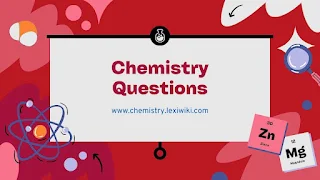Questions on Charles’s Law
Charles’s Law – Multiple Choice Questions
1. Charles’s Law relates which two properties of a gas?
A) Pressure and volume
B) Pressure and temperature
C) Volume and temperature
D) Mass and volume
E) Density and pressure
2. According to Charles’s Law, at constant pressure, the volume of a gas is:
A) Inversely proportional to temperature
B) Directly proportional to temperature
C) Independent of temperature
D) Equal to pressure
E) Unaffected by molecular mass
3. What condition must remain constant for Charles’s Law to apply?
A) Volume
B) Pressure
C) Temperature
D) Mass
E) Molarity
4. Charles’s Law is mathematically expressed as:
A) PV = constant
B) V/T = constant
C) P/T = constant
D) VT = constant
E) V = nRT/P
5. If the temperature of a gas increases, what happens to its volume (assuming constant pressure)?
A) It decreases
B) It remains unchanged
C) It increases
D) It doubles
E) It becomes zero
6. Which temperature scale must be used in Charles’s Law calculations?
A) Celsius
B) Fahrenheit
C) Rankine
D) Kelvin
E) Centigrade
7. A gas has a volume of 2.0 L at 300 K. What is the volume at 600 K, assuming pressure remains constant?
A) 1.0 L
B) 2.0 L
C) 4.0 L
D) 6.0 L
E) 3.0 L
8. If the temperature of a gas is halved (in Kelvin), its volume will:
A) Double
B) Stay the same
C) Be halved
D) Triple
E) Drop to zero
9. Charles's Law best describes the behavior of:
A) Solids
B) Liquids
C) Ideal gases
D) Ionic compounds
E) Metals
10. Which of the following would violate Charles’s Law?
A) Heating gas in a piston
B) Cooling gas in a balloon
C) Keeping pressure constant
D) Changing pressure during heating
E) Using Kelvin for temperature
11. What is the physical significance of Charles’s Law?
A) Gas pressure varies inversely with volume
B) Volume of gas changes with temperature
C) Gases have mass
D) Pressure increases with mass
E) Gases form liquids under pressure
12. Charles's Law helps explain why:
A) Submarines sink in water
B) Hot air balloons rise
C) Oil floats on water
D) Gases diffuse through solids
E) Metal expands when heated
13. In a graph of Volume vs. Temperature (in Kelvin), the line for Charles’s Law is:
A) Curved upward
B) Curved downward
C) A horizontal line
D) A straight line
E) A parabolic arc
14. If a gas occupies 5.0 L at 250 K, what volume will it occupy at 500 K (constant pressure)?
A) 2.5 L
B) 5.0 L
C) 10.0 L
D) 7.5 L
E) 12.5 L
15. What happens to gas volume if the temperature drops to absolute zero (0 K), according to Charles’s Law?
A) Volume becomes infinite
B) Volume becomes zero
C) Volume increases slightly
D) Nothing changes
E) Gas turns to liquid
16. In reality, gases do not reach 0 K because:
A) Pressure increases rapidly
B) Atoms cease to exist
C) All motion stops
D) They expand infinitely
E) They ionize at that point
17. A gas expands from 3.0 L to 6.0 L. If the initial temperature was 150 K, what is the final temperature?
A) 100 K
B) 200 K
C) 300 K
D) 250 K
E) 450 K
18. Charles’s Law assumes the gas behaves:
A) As a liquid
B) As a solid
C) Ideally
D) Non-linearly
E) As a plasma
19. Which of the following devices best demonstrates Charles's Law?
A) Spectrometer
B) Bunsen burner
C) Hot air balloon
D) Light bulb
E) Digital thermometer
20. A balloon inflated indoors at room temperature will:
A) Shrink when taken outside in cold weather
B) Burst due to heat loss
C) Collapse due to lower air pressure
D) Float due to heavier air
E) Stay the same size
Answers with Explanations
1. C – Charles’s Law connects volume and temperature.
2. B – Volume increases directly with temperature if pressure is constant.
3. B – Pressure must remain constant for Charles’s Law.
4. B – V/T = constant is the correct form.
5. C – Volume increases with temperature rise.
6. D – Temperature must be in Kelvin to avoid negative values.
7. C – V₁/T₁ = V₂/T₂ → 2/300 = V/600 → V = 4.0 L.
8. C – Halving temperature → halving volume (direct proportion).
9. C – Ideal gases are modeled by Charles’s Law.
10. D – Changing pressure violates the law’s assumptions.
11. B – Charles’s Law explains how volume changes with temperature.
12. B – Hot air rises because warm gas expands, lowering its density.
13. D – The relationship is linear (V vs T in Kelvin).
14. C – 5.0/250 = V/500 → V = 10.0 L.
15. B – Theoretically, volume reaches zero at 0 K.
16. C – At 0 K, molecular motion stops (theoretical only).
17. C – 3/150 = 6/T → T = 300 K.
18. C – The law assumes ideal gas behavior.
19. C – Hot air balloons expand with temperature, illustrating Charles’s Law.
20. A – Cooler outdoor air lowers temperature, shrinking the balloon.
Dive into the groundbreaking science of neurotransmitters—your brain’s invisible architects—in Chemical Harmony: How Neurotransmitters Shape Our Lives (2025). This meticulously researched book reveals how serotonin, dopamine, GABA, and other brain chemicals silently orchestrate every aspect of your existence, from decision-making and relationships to mental health and emotional resilience.Click here to buy
Share Online!

